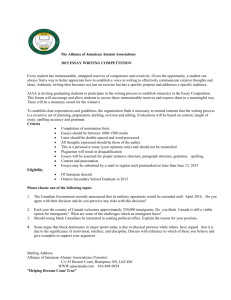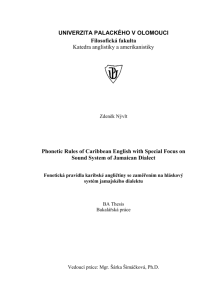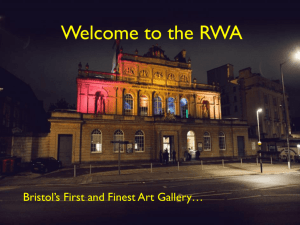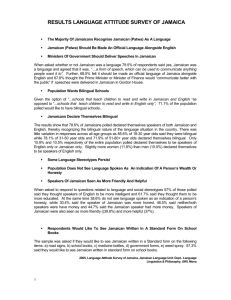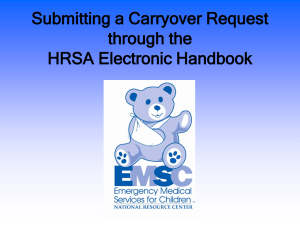Jamaican Culture
advertisement
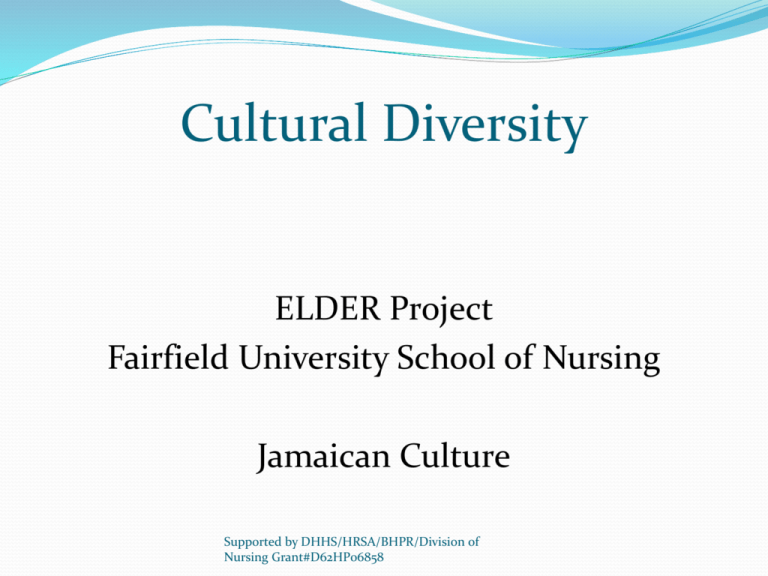
Cultural Diversity ELDER Project Fairfield University School of Nursing Jamaican Culture Supported by DHHS/HRSA/BHPR/Division of Nursing Grant#D62HP06858 Jamaican Culture Objectives: Upon completion of this session, the participants will be able to …. Discuss the role of religion, traditional health care beliefs, social values, and family structure of Jamaican Culture and the impact these factors have on health care. Identify specific culturally sensitive practices that can be incorporated into your work with Jamaican patients and Jamaican American patients. Identify similarities and differences between the Jamaican and Haitian cultures. Supported by DHHS/HRSA/BHPR/Division of Nursing Grant#D62HP06858 Jamaican Culture Introduction: The Jamaican culture is often identified with that of African Americans; however, they have a distinct history and culture of their own. Most Jamaicans are descendants of British-owned slaves from Africa, accounting for the blend of British and African traditions. Their history of slavery and resistance to it has lead them to develop independent spirits. Jamaicans are known for being hard workers with a strong respect for education. Factors that prompted this culture group to come to the U.S. included a decline in the Jamaican economy, unemployment and unequal distribution of land within a primarily agricultural nation. Supported by DHHS/HRSA/BHPR/Division of Nursing Grant#D62HP06858 Jamaican Culture Introduction: The country of Jamaica is a West Indian island located near the center of the Caribbean Sea. It is among the group of islands that comprise the Greater Antilles (the others are Cuba, Haiti, Dominican Republic and Puerto Rico) and is the largest of the English–speaking islands in the region. It is roughly the same size as Connecticut. Supported by DHHS/HRSA/BHPR/Division of Nursing Grant#D62HP06858 Supported by DHHS/HRSA/BHPR/Division of Nursing Grant#D62HP06858 Jamaican Culture Introduction: Brief Timeline: 1494 – Columbus discovers the island on his way to Cuba. Originally inhabited by the Anwak or Tianos (who possibly came from Guayna). They were treated poorly by the Spaniards and within 50 years the natives all died, thus began the slave trade from Africa. 1655 – Spanish surrendered the Island to the British (Sir Oliver Cromwell) and they established a plantation economy 1807 – Slave trade abolished 1838 – Slave were freed from slavery 1962 – Jamaica became a free independent nation Supported by DHHS/HRSA/BHPR/Division of Nursing Grant#D62HP06858 Jamaican Culture Communication: Greeting and acknowledgment of a person’s presence is an important part of Jamaican culture. Use of titles of Miss, Mrs. And Mr. before one’s name is important. In less formal settings title precedes a first name only. Supported by DHHS/HRSA/BHPR/Division of Nursing Grant#D62HP06858 Jamaican Culture Family and Social Structure: Families are strong and loyal and a great importance is placed on the sense of duty and responsibility toward the family. The extended family is the traditional family model, with members all living in the same house and involved in child rearing. Contemporary Jamaican families are becoming more nuclear. Kinship bonds extend to close friends and neighbors who contribute to raising children. Supported by DHHS/HRSA/BHPR/Division of Nursing Grant#D62HP06858 Jamaican Culture Family and Social Structure: Marriage is the norm and Jamaicans are encouraged to marry within their own socioeconomic class. Cohabitation is frowned upon because it does not give legitimacy to children, it lowers the family status and is viewed as immoral. The woman is the primary financial provider for the family. The male is sometimes viewed as not reliable or not involved in the family. Supported by DHHS/HRSA/BHPR/Division of Nursing Grant#D62HP06858 Jamaican Culture Family and Social Structure: The oldest child is often responsible for keeping the family intact. The oldest male is seen as a surrogate father. The oldest female is considered the caregiver and decision maker for aging parents. It is not unusual to have siblings and extended family participate in consultations with health professionals. Final decisions are those of the oldest sibling. Education is valued because it is a means of upward mobility from the lower class. Supported by DHHS/HRSA/BHPR/Division of Nursing Grant#D62HP06858 Jamaican Culture View of Illness: Health is considered the presence or absence of illness. Illness is viewed as a punishment for wrongdoing or sin, which causes great shame and guilt. This punishment is believed to be passed on to next generation as well as the victim. Natural causes for illnesses and disabilities are generally accepted by the more sophisticated. Illness is seen more as a mistake from the medical professionals or a failure of the body to heal itself. Those who accept this belief seek out the help of the medical professional to alleviate suffering and find cures. Supported by DHHS/HRSA/BHPR/Division of Nursing Grant#D62HP06858 Jamaican Culture View of Illness: Obeah or Guzu is the belief that supernatural forces can be the cause of good and evil, health or sickness. Any illness that can not be explained by medical intervention is considered to be a result of Obeah. This may prompt the use of rituals, herbs, baths and oils for anointing the body. Recitation of biblical scripture may take place as well. Supported by DHHS/HRSA/BHPR/Division of Nursing Grant#D62HP06858 Jamaican Culture Folk Medicine: Some Jamaicans may tend to self-medicate before seeking a physician. Spiritual herbalists believe the use of herbs and religious ritual can enhance the body’s ability to fight illness. Elders have a great deal of herbal wisdom and will combine their beliefs with traditional medicine. Supported by DHHS/HRSA/BHPR/Division of Nursing Grant#D62HP06858 Jamaican Culture Folk Medicine: Herbs are also used for health maintenance. For example, Senna, Epson salt or castor oil is used to cleanse the bowel of worms and purifying the body. A variety of cultural remedies may be used to treat illnesses, such as: “bush tea” (herbal remedy) for gastrointestinal disorders papaya juice for ulcers hot peppers for hypertension Those who lack financial resources are forced to use home remedies. Supported by DHHS/HRSA/BHPR/Division of Nursing Grant#D62HP06858 Jamaican Culture Dietary Habits: A large amount of carbohydrates such as rice, yams, sweet potatoes, bananas, plantains and peas are consumed. Protein consumption is that of fish, beef, pork, poultry and goat. Usually eaten in small portions. American Jamaicans tend to consume more meat and larger portions. Active lifestyle in Jamaica helps metabolize the carbohydrates and fats in the diet. In the U.S. there is more of a sedentary lifestyle which subjects this culture group to cardiovascular disease and diabetes. Supported by DHHS/HRSA/BHPR/Division of Nursing Grant#D62HP06858 Jamaican Culture Religious Beliefs: Religion is an integral part of life, dating back to the times of slavery. Many are involved in a great deal of church related activities, such as prayer meetings, bible study and choir practice. Religious education is included in all levels of education. Church attendance strengthens the extended family and kinship bonds. The church is a source of information, emotional and financial support and serves as a social outlet. Supported by DHHS/HRSA/BHPR/Division of Nursing Grant#D62HP06858 Jamaican Culture Religious Beliefs: Jamaicans are affiliated with many religions and sects resulting in more than 100 Christian religious practices. Many identify themselves predominately as Protestants with a small percentage of Roman Catholic. There are a number of religions of African origin, usually blended with Christian ideology. Church membership is related to social class. Upper and middle class gravitate towards stoical and non- emotional religions such as Anglican or Methodist. Supported by DHHS/HRSA/BHPR/Division of Nursing Grant#D62HP06858 Jamaican Culture Conclusion: Jamaicans are rich in cultural tradition and ethnic diversity. The national motto, “Out of many, one people” represents the population’s multi-racial roots from Africa, Europe, China, East India and the Middle East. Although many Jamaican Americans are naturalized citizens, they often wrestle with the issue of split national allegiance to Jamaica and the United States. Supported by DHHS/HRSA/BHPR/Division of Nursing Grant#D62HP06858 Reference Jamaican History. Retrieved on April 7th, 2010 from http://www.discoverjamaica.com/gleaner/discover/geogra phy/history1.htm The World Factbook: Jamaica. Retrieved on April 7th, 2010 from https://www.cia.gov/library/publications/the-worldfactbook/geos/jm.html Miller, D. (2002). An Introduction to Jamaican Culture for Rehabilitation Services Providers. Retieved January 11, 2011 from http://cirrie.buffalo.edu/monographs/jamaica.php. Supported by DHHS/HRSA/BHPR/Division of Nursing Grant#D62HP06858 Power Point Presentation Created by: Joyce Cunneen, MSN, RN Fairfield University School of Nursing ELDER Project Education Coordinator Monica Starr, BSN, RN Fairfield University School of Nursing ELDER Project Program Coordinator Supported by DHHS/HRSA/BHPR/Division of Nursing Grant#D62HP06858

